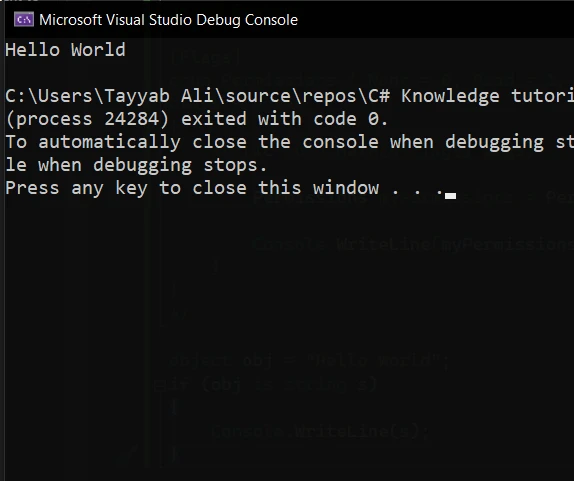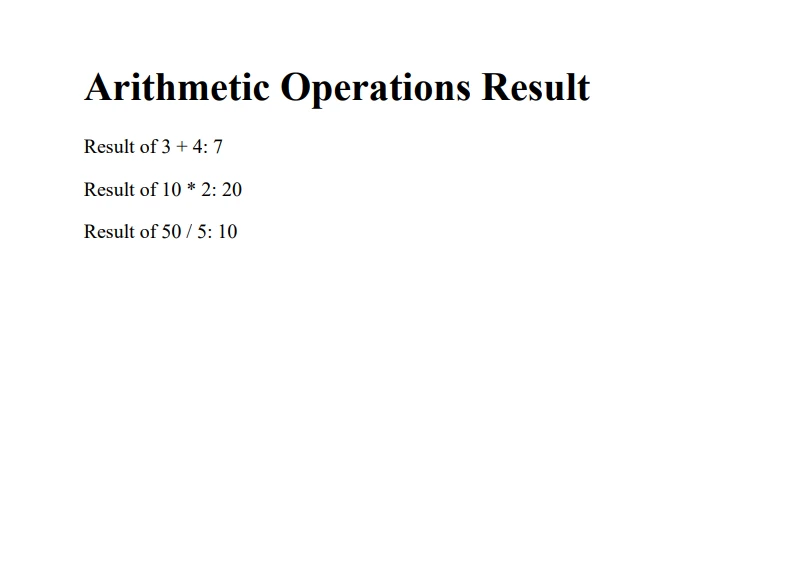Test in production without watermarks.
Works wherever you need it to.
Get 30 days of fully functional product.
Have it up and running in minutes.
Full access to our support engineering team during your product trial
C# is a powerful, type-safe programming language that offers developers a rich set of features for building complex applications. At the heart of many programming tasks are operators - the building blocks that allow us to perform operations on variables and values. This article dives into various types of operators such as arithmetic operators, focusing on their precedence, usage, and the introduction of some new features that enhance the language's capabilities. We'll also cover the IronPDF library as a comprehensive .NET PDF tool for .NET applications.
Arithmetic operators, essential in any programming language for numeric manipulation, perform operations such as addition, subtraction, multiplication, and division among others on numeric operands. This section covers each operator's name, and description, and provides examples to illustrate their use in C#.
For instance, consider the basic arithmetic operations:
These are straightforward, with the operands being the values or variables involved in the operation, such as x, y, and z in the examples above.
An interesting unary arithmetic operator is numeric negation (-), which reverses the sign of a numeric operand. For example, if we have int x = 5;, then -x would result in -5.
Binary operators, denoted as "op" in expressions like x op y, require two operands to perform their operations. For instance, in x + y, "+" is the binary operator, with x and y as its operands. Understanding operator precedence is crucial for accurately evaluating expressions with multiple operators.
Consider the following example: int result = 3 + 4 2;. Here, the multiplication operation has higher precedence than addition, so 4 2 is evaluated first, followed by adding 3 to the result, yielding 11.
A notable new feature in C# is the null coalescing operator (??), which provides a concise way to check for null values. This operator returns the left-hand operand if it is not null; otherwise, it returns the right-hand operand as shown in the following example.
class Program
{
static void Main(string [] args)
{
int? x = null;
int y = x ?? -1;
Console.WriteLine("The value of y is: " + y);
}
}class Program
{
static void Main(string [] args)
{
int? x = null;
int y = x ?? -1;
Console.WriteLine("The value of y is: " + y);
}
}Friend Class Program
Shared Sub Main(ByVal args() As String)
Dim x? As Integer = Nothing
Dim y As Integer = If(x, -1)
Console.WriteLine("The value of y is: " & y)
End Sub
End ClassIn this example, y would be -1 because x is null. The null coalescing operator simplifies checks for null values, especially when working with nullable types.

C# has added a feature called the null coalescing assignment operator, symbolized by ??=. This operator checks if the variable on its left side is null. If it is, the operator assigns the value from the right side to the left side variable form.
int? a = null;
a ??= 10;int? a = null;
a ??= 10;Dim a? As Integer = Nothing
a = If(a, 10)Here, a would be 10 after the operation because it was initially null. This operator streamlines code by reducing the need for explicit null checks and assignments.
Lambda declarations and type testing are more advanced features that leverage operators for concise and powerful functionality.
Lambda expressions in C# use the lambda operator (=>) to create inline functions. For instance:
Func<int, int, int> add = (x, y) => x + y;
int sum = add(5, 3);Func<int, int, int> add = (x, y) => x + y;
int sum = add(5, 3);Dim add As Func(Of Integer, Integer, Integer) = Function(x, y) x + y
Dim sum As Integer = add(5, 3)This code snippet defines a simple function to add two integer values using a lambda expression.
Type testing is performed using the is operator, allowing you to check the type at runtime. For example:
object obj = "Hello World";
if (obj is string s) {
Console.WriteLine(s);
}object obj = "Hello World";
if (obj is string s) {
Console.WriteLine(s);
}Dim obj As Object = "Hello World"
Dim tempVar As Boolean = TypeOf obj Is String
Dim s As String = If(tempVar, DirectCast(obj, String), Nothing)
If tempVar Then
Console.WriteLine(s)
End IfThis checks if obj is of type string and assigns it to s if true.


When dealing with document generation and manipulation in C#, managing PDF files is a common requirement. IronPDF stands out as a comprehensive library designed to enable developers to create PDFs from HTML with IronPDF, and read, and edit PDF documents directly within .NET applications without needing any dependency. This section explores how IronPDF can be integrated into C# projects, especially focusing on operations related to our earlier discussion on operators and variables.
Before diving into the capabilities of IronPDF, the first step is to integrate the library into your project. IronPDF can be easily added via NuGet, a popular package manager for .NET. By using the NuGet Package Manager, you can include IronPDF in your project with minimal effort.
To install IronPDF, you can use the Package Manager Console command:
Install-Package IronPdf
Alternatively, you can use the NuGet Package Manager UI in Visual Studio by searching for "IronPdf" and installing it directly into your project.
Once IronPDF is added to your project, you can start utilizing its features to generate and manipulate PDF documents. Here's a simple example demonstrating how to create a PDF document that includes the result of arithmetic operations, tying back to our discussion on operators.
using IronPdf;
public class PdfGenerationExample
{
public static void CreatePdfWithArithmeticOperations()
{
// Create a new PDF document
var pdf = new HtmlToPdf();
// HTML content with embedded C# arithmetic
var htmlContent = @"
<html>
<body>
<h1>Arithmetic Operations Result</h1>
<p>Result of 3 + 4: " + (3 + 4).ToString() + @"</p>
<p>Result of 10 * 2: " + (10 * 2).ToString() + @"</p>
<p>Result of 50 / 5: " + (50 / 5).ToString() + @"</p>
</body>
</html>";
// Convert HTML to PDF
var document = pdf.RenderHtmlAsPdf(htmlContent);
// Save the PDF to a file
document.SaveAs("ArithmeticOperations.pdf");
}
}using IronPdf;
public class PdfGenerationExample
{
public static void CreatePdfWithArithmeticOperations()
{
// Create a new PDF document
var pdf = new HtmlToPdf();
// HTML content with embedded C# arithmetic
var htmlContent = @"
<html>
<body>
<h1>Arithmetic Operations Result</h1>
<p>Result of 3 + 4: " + (3 + 4).ToString() + @"</p>
<p>Result of 10 * 2: " + (10 * 2).ToString() + @"</p>
<p>Result of 50 / 5: " + (50 / 5).ToString() + @"</p>
</body>
</html>";
// Convert HTML to PDF
var document = pdf.RenderHtmlAsPdf(htmlContent);
// Save the PDF to a file
document.SaveAs("ArithmeticOperations.pdf");
}
}Imports IronPdf
Public Class PdfGenerationExample
Public Shared Sub CreatePdfWithArithmeticOperations()
' Create a new PDF document
Dim pdf = New HtmlToPdf()
' HTML content with embedded C# arithmetic
Dim htmlContent = "
<html>
<body>
<h1>Arithmetic Operations Result</h1>
<p>Result of 3 + 4: " & (3 + 4).ToString() & "</p>
<p>Result of 10 * 2: " & (10 * 2).ToString() & "</p>
<p>Result of 50 / 5: " & (50 \ 5).ToString() & "</p>
</body>
</html>"
' Convert HTML to PDF
Dim document = pdf.RenderHtmlAsPdf(htmlContent)
' Save the PDF to a file
document.SaveAs("ArithmeticOperations.pdf")
End Sub
End ClassIn this example, we create a simple HTML template that includes the results of various arithmetic operations, similar to what we discussed earlier. IronPDF renders this HTML content into a PDF document, showcasing how seamlessly C# code and HTML can be combined to generate dynamic documents.

Operators in C# are essential for performing various kinds of operations, from basic arithmetic to complex type testing and lambda expressions. Understanding these operators, their precedence, and how to use them effectively is crucial for any developer looking to master C#. IronPDF offers a free trial for developers to explore its features and capabilities. Should you decide to integrate it into your production environment, licensing starts from $749. With the introduction of new features like the null coalescing assignment operator, C# continues to evolve, offering more efficient and concise ways to write code.